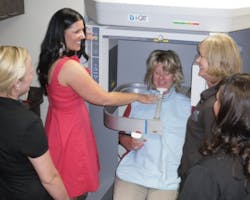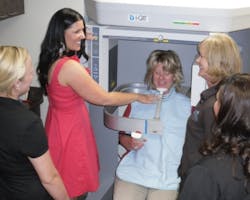The implant-based practice
Justin Moody, DDS
For more on this topic, go to www.dentaleconomics.com and search using the following key words: dental technology, 3-D imaging, CBCT, implants, Justin Moody, DDS.
When considering dental economics, expanding a dental practice to offer more services to patients is always a good investment. The field of implants has increased treatment options for patients, yet finding safe and efficient ways of implementing these options in the practice is often a challenge. One way of getting precise information for the best treatment decisions for implants is through 3-D imaging.
I listen to experts in the field. Well-known oral and maxillofacial radiologist Dr. Alan Farman recently stated, “After having read thousands of CBCT volumes, it is my professional judgment that CBCT is useful in planning most, if not all, dental implant placements.” This statement echoes what my experience has been with cone beam, and solidifies the investment I’ve made in the technology.
By the time this article is published, I will have three CBCT scanners (GXCB-500 HD™ from Gendex) in my dental implant centers in South Dakota, Nebraska, and Minnesota. Since these locations are limited to dental implants, I felt that this model, a medium field-of-view, is the appropriate choice.
With these three-dimensional scans, I can see everything I need for implant-related procedures. Plus, I can take advantage of CAD/CAM applications specific to placing and restoring implants.
My machines allow me to focus on a specific area of interest, through their ability to collimate. This also helps me to limit the amount of radiation exposure to my patients, while still using state-of-the-art equipment to obtain the highest diagnostic quality image.
I need the high-quality image to produce high-quality dental work with the least amount of radiation. The machine also has the capacity to transform into a standard 2-D panoramic unit, so it also eliminates the need for an extra machine in these offices.
In my opinion, when planning for implants, the ability to view the bone volume in three dimensions is essential, not optional. Having the “surgical view” of the scan reduces surgical time and uncertainty. Using 2-D imaging, this information would be unavailable to me until I laid a large flap. Finding complications at that point is stressful for both me and my patient.
Obtaining exact measurements also gives me the data I need to decide which type and size of implants will produce the best results. Preplanning lets me have the exact inventory of implants that I need vs. having a large and varied inventory that I would need to provide for all of the unknowns. 3-D is especially helpful in large full-arch cases needing six or eight implants of various sizes. CBCT preplanning for this type of situation can save thousands of dollars in unnecessary products.
While even the best laid plans can change, having the right technology can keep modifications to a minimum and save stress, time, and money. An implant practice needs this extra dimension in imaging to change informed plans into successful realities.
Dr. Justin Moody is a diplomate with the American Board of Oral Implantology/Implant Dentistry and the International Congress of Oral Implantologists, and an associate fellow with the American Academy of Implant Dentistry. He also holds mastership and fellow status at the Misch International Implant Institute. He can be reached at [email protected].

